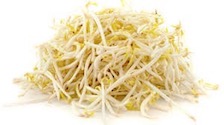Much to Know About Sprouts! (Dedicated)
Did you Know?

Sprouts are a “living food.” Unlike other fruit and vegetables, which lose a significant amount of vitamins by the time they reach your table, sprouts continue to produce nutrients after being harvested.
Sprouts Have a Higher Nutritional Content Than Any Other Food. A sprouted seed, bean or nut has many times the nutritional value than the non- sprouted version. Replacing the lettuce in your salad with sprouts will give you 5 times the protein, 6 times the Vitamin C and 7 times the B Complex Vitamins.
The Most Enzyme-Rich Food You Can Find. Enzymes act as a catalyst for the chemical reactions in our bodies while helping us digest essential nutrients in our food. A sprouted seed, nut or bean has a whopping 43 times the enzyme power when compared to the non-sprouted version.
Sprouts Are High in Anti-Oxidants. Anti-oxidants protect our DNA from damage and slow down the effects of aging.
Green Sprouts (ie. Alfalfa and Wheat Grass) Are Rich In Chlorophyll. Chlorophyll cleanses our blood and detoxifies our system. It has the ability to regenerate our bodies on a cellular and molecular level.
The Amazing Power of Sprouts!
Clover Sprouts contain significant dietary sources of phytoestrogens which have been connected with prevention of menopausal symptoms, osteoporosis, cancer and heart disease. They also contain the most significant dietary sources of isoflavones of any sprout variety. Isoflavones may have powerful anti-cancer properties.
Uses: Salads, sandwiches

Broccoli Sprouts have a mildly peppery flavor.
They are also high in the cancer-fighting compound, sulforaphane. “Three-day-old broccoli sprouts consistently contain 20 to 50 times the amount of chemoprotective compounds found in mature broccoli heads and may offer a simple dietary means of chemically reducing cancer risk,” Dr. Paul Talalay reported in a 1997 Johns Hopkins press release.

Alfalfa Sprouts are one of our finest food sources of saponins. Saponins may help lower the bad cholesterol and fat but not the good HDL fats.
Uses: Great texture in sandwiches, salads and omelets

Mung Bean Sprouts are a good source of protein, fiber and vitamin C. Because they are harvested early, Jonathan’s Mung Bean Sprouts are more nutrient dense. They are considered useful in defending against several chronic, age-related diseases, including heart disease, cancer, diabetes and obesity.
Uses: Perfect for many Asian dishes. Best when lightly cooked.

Pea Shoots are an incredible source of antioxidants, phytonutrients, enzymes, oxygen, minerals and vitamins. They help to alkalize your body, support your immune system and ensure proper cell regeneration.
* Seven times more vitamin C than blueberries; * Eight times more folic acid than bean sprouts;
* Four times more Vitamin A than tomatoes; * Up to 69% of high quality bioavailable protein.
Uses: Stir fry, casseroles, salads, side dish, juice

Radish Sprouts have 29 times more vitamin C than milk and 4 times the vitamin A. These spicy sprouts have 10 times more calcium than a potato and contain more vitamin C than pineapple.
Uses: Too delicate for cooking, radish sprouts are generally used to spice up salads or sandwiches.

